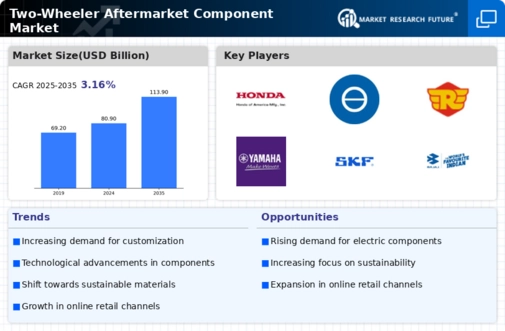The competitive insights of the Two-Wheeler Aftermarket Component Market reveal dynamic interaction among key players, extensive product offerings, and innovative strategies that dictate market trends. The aftermarket segment for two-wheelers essentially includes components and services provided to end-users after the initial sale of the vehicles.
A variety of factors influence competition in this sector, including brand loyalty, product quality, supply chain efficiency, and technological advancements. Market players are increasingly focusing on enhancing their distribution networks to ensure broader accessibility of their products.
Moreover, as the rise of electric and hybrid two-wheelers creates shifts in consumer preferences, companies must adapt their offerings accordingly. The integration of advanced materials and smart technologies into aftermarket components is reshaping the landscape as stakeholders aim to enhance performance and reliability.
In the Two-Wheeler Aftermarket Component Market, Honda has established a strong presence characterized by its commitment to quality and customer satisfaction. Renowned for its extensive research and development capabilities, Honda continually innovates its aftermarket components to maintain a competitive edge.
The company's ability to offer a comprehensive range of high-performance parts ensures that a wide array of consumer needs is met, thereby bolstering brand loyalty. The strength of its service network also plays a pivotal role in reinforcing Honda's market position. By providing efficient and reliable service through authorized dealerships and workshops, Honda enhances customer trust and delivers value.
Furthermore, its proactive approach to sustainability and eco-friendly product development resonates well with the growing trend towards environmentally conscious consumerism, further solidifying its competitive stance in this market.
FederalMogul, in the Two-Wheeler Aftermarket Component Market, is recognized for its innovative technologies and high-quality manufacturing standards, which cater to a diverse clientele. The company focuses on providing a broad spectrum of aftermarket solutions, including engine components, electrical systems, and performance parts that comply with stringent quality assurance measures.
FederalMogul's robust supply chain and strategic partnerships enhance its distribution capabilities, allowing for the efficient delivery of products to various regions. Additionally, its dedicated research and development investments lead to the continual introduction of upgraded and superior products that meet evolving market demands.
With a commitment to customer engagement and educational initiatives, FederalMogul ensures that its clients are well-informed about product offerings, maintenance practices, and installation procedures, thereby fostering strong relationships and enhancing customer loyalty.























Leave a Comment